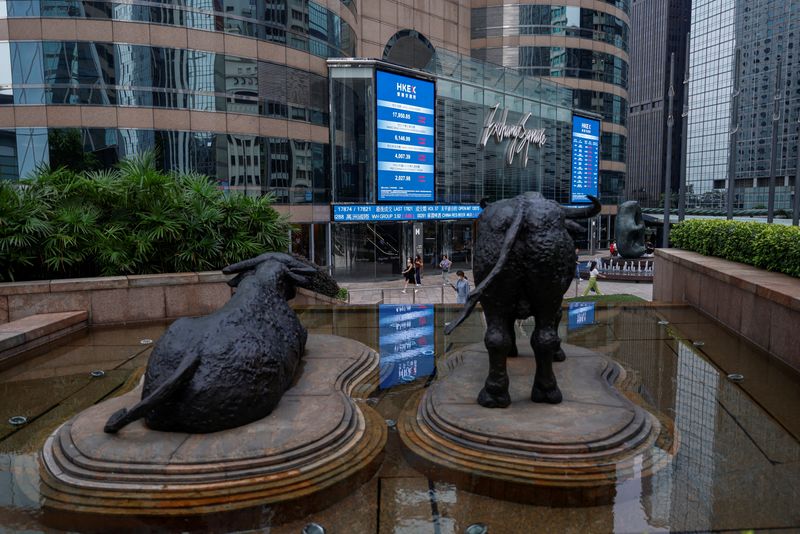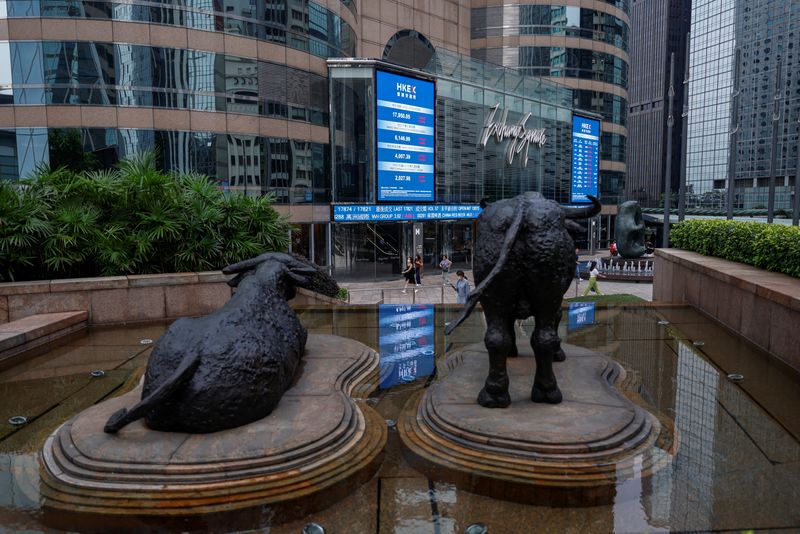Economy
Shares gain, dollar slips as Fed’s Powell sounds caution


© Reuters. FILE PHOTO: Bull statues are placed in font of screens showing the Hang Seng stock index and stock prices outside Exchange Square, in Hong Kong, China, August 18, 2023. REUTERS/Tyrone Siu
By Sinéad Carew and Amanda Cooper
NEW YORK/LONDON (Reuters) – MSCI’s global stock index gained ground on Friday, while the U.S. dollar slipped after Federal Reserve Chair Jerome Powell vowed to move “carefully” on interest rates.
Treasury yields were down in choppy trading after data showed a continued slump in manufacturing and Powell said the risks of hiking interest rates too much and slowing the economy more than necessary, have become “more balanced” with the risks of not hiking enough to control inflation.
“Powell did his utmost to subtly convince markets of the Federal Reserve’s commitment to holding rates in restrictive territory for a prolonged period of time,” said Karl Schamotta, chief market strategist at Corpay in Toronto.
“But we doubt this will deter investors betting on a dramatic pivot in early 2024,” he added citing comments from Fed Governor Christopher Waller earlier this week. Widely seen as a more hawkish policymaker, Waller flagged the possibility of lower interest rates if inflation continued to ease.
“By providing the terms – and the timeline – for a rules-based reduction in policy rates next year, Governor Waller earlier this week cleared the way for a sustained, data-driven decline in yields and the dollar.”
The rose 85.32 points, or 0.24%, to 36,036.21, the gained 5.88 points, or 0.13%, to 4,573.68 and the dropped 7.74 points, or 0.05%, to 14,218.48.
The pan-European index rose 0.97%, while MSCI’s gauge of stocks across the globe was up 0.21% after registering its biggest monthly gain in three years for November.
Earlier, the Institute for Supply Management (ISM) said its manufacturing PMI was unchanged at 46.7 last month. It was the 13th consecutive month that the PMI stayed below 50, indicating a contraction in manufacturing and the longest such stretch since the period from August 2000 to January 2002.
Mona Mahajan, senior investment strategist at Edward Jones said the data supported the idea of lower inflation and a gradually cooling economy.
“We’re encouraged that markets aren’t pulling back in any meaningful way after the strong November and may have scope to build on those gains if we continue to see these fundamental drivers play out,” said Mahajan.
In Treasuries, benchmark 10-year notes were down 8.4 basis points to 4.266%, from 4.35% late on Thursday. The 30-year bond was last down 6.3 basis points to yield 4.448%. The was last was down 11.7 basis points to yield 4.5984%.
In currencies, the fell 0.058%, with the euro down 0.2% to $1.0864. The Japanese yen strengthened 0.64% versus the greenback at 147.25 per dollar.
Sterling was last trading at $1.2665, up 0.34% on the day supported by expectations that the Bank of England will take longer than either the Fed or the ECB to cut rates.
Oil prices extended losses slightly after Thursday’s 2% drop, with the market unconvinced that the latest round of OPEC+ production cuts will be able to lift prices from a recent slump.
recently fell 0.13% to $75.86 per barrel and was at $80.75, down 0.14% on the day.
In precious metals, added 1.1% to $2,058.19 an ounce. U.S. gained 0.64% to $2,051.10 an ounce.
Economy
Russian central bank says it needs months to make sure CPI falling before rate cuts -RBC


© Reuters. Russian Central Bank Governor Elvira Nabiullina attends a news conference in Moscow, Russia June 14, 2019. REUTERS/Shamil Zhumatov/File Photo
MOSCOW (Reuters) – Russia’s central bank will need two to three months to make sure that inflation is steadily declining before taking any decision on interest rate cuts, the bank’s governor Elvira Nabiullina told RBC media on Sunday.
The central bank raised its key interest rate by 100 basis points to 16% earlier in December, hiking for the fifth consecutive meeting in response to stubborn inflation, and suggested that its tightening cycle was nearly over.
Nabiullina said it was not yet clear when exactly the regulator would start cutting rates, however.
“We really need to make sure that inflation is steadily decreasing, that these are not one-off factors that can affect the rate of price growth in a particular month,” she said.
Nabiullina said the bank was taking into account a wide range of indicators but primarily those that “characterize the stability of inflation”.
“This will take two or three months or more – it depends on how much the wide range of indicators that characterize sustainable inflation declines,” she said.
The bank will next convene to set its benchmark rate on Feb. 16.
The governor also said the bank should have started monetary policy tightening earlier than in July, when it embarked on the rate-hiking cycle.
Economy
China identifies second set of projects in $140 billion spending plan


© Reuters. FILE PHOTO: Workers walk past an under-construction area with completed office towers in the background, in Shenzhen’s Qianhai new district, Guangdong province, China August 25, 2023. REUTERS/David Kirton/File Photo
SHANGHAI (Reuters) – China’s top planning body said on Saturday it had identified a second batch of public investment projects, including flood control and disaster relief programmes, under a bond issuance and investment plan announced in October to boost the economy.
With the latest tranche, China has now earmarked more than 800 billion yuan of its 1 trillion yuan ($140 billion) in additional government bond issuance in the fourth quarter, as it focuses on fiscal steps to shore up the flagging economy.
The National Development and Reform Commission (NDRC) said in a statement on Saturday it had identified 9,600 projects with planned investment of more than 560 billion yuan.
China’s economy, the world’s second largest, is struggling to regain its footing post-COVID-19 as policymakers grapple with tepid consumer demand, weak exports, falling foreign investment and a deepening real estate crisis.
The 1 trillion yuan in additional bond issuance will widen China’s 2023 budget deficit ratio to around 3.8 percent from 3 percent, the state-run Xinhua news agency has said.
“Construction of the projects will improve China’s flood control system, emergency response mechanism and disaster relief capabilities, and better protect people’s lives and property, so it is very significant,” the NDRC said.
The agency said it will coordinate with other government bodies to make sure that funds are allocated speedily for investment and that high standards of quality are maintained in project construction.
($1 = 7.1315 renminbi)
Economy
Russian central bank says it needs months to make sure CPI falling before rate cuts -RBC


© Reuters. Russian Central Bank Governor Elvira Nabiullina attends a news conference in Moscow, Russia June 14, 2019. REUTERS/Shamil Zhumatov/File Photo
MOSCOW (Reuters) – Russia’s central bank will need two to three months to make sure that inflation is steadily declining before taking any decision on interest rate cuts, the bank’s governor Elvira Nabiullina told RBC media on Sunday.
The central bank raised its key interest rate by 100 basis points to 16% earlier in December, hiking for the fifth consecutive meeting in response to stubborn inflation, and suggested that its tightening cycle was nearly over.
Nabiullina said it was not yet clear when exactly the regulator would start cutting rates, however.
“We really need to make sure that inflation is steadily decreasing, that these are not one-off factors that can affect the rate of price growth in a particular month,” she said.
Nabiullina said the bank was taking into account a wide range of indicators but primarily those that “characterize the stability of inflation”.
“This will take two or three months or more – it depends on how much the wide range of indicators that characterize sustainable inflation declines,” she said.
The bank will next convene to set its benchmark rate on Feb. 16.
The governor also said the bank should have started monetary policy tightening earlier than in July, when it embarked on the rate-hiking cycle.

 Forex2 years ago
Forex2 years agoForex Today: the dollar is gaining strength amid gloomy sentiment at the start of the Fed’s week

 Forex2 years ago
Forex2 years agoHow is the Australian dollar doing today?

 Forex1 year ago
Forex1 year agoUnbiased review of Pocket Option broker

 Forex2 years ago
Forex2 years agoDollar to pound sterling exchange rate today: Pound plummeted to its lowest since 1985

 Cryptocurrency2 years ago
Cryptocurrency2 years agoWhat happened in the crypto market – current events today

 World2 years ago
World2 years agoWhy are modern video games an art form?

 Stock Markets2 years ago
Stock Markets2 years agoMorgan Stanley: bear market rally to continue

 Economy2 years ago
Economy2 years agoCrude oil tankers double in price due to EU anti-Russian sanctions

































